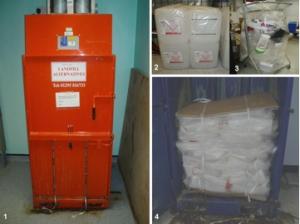- Group home
- You must register/login in order to post into this group.
Diversion of Waste to the Recycling Stream through the Use of Baling Machines

By: Heart of England NHS Foundation Trust
environmental benefits resulting from the diversion of waste to the recycling stream, 4.2tonnes of less plastic going to clinical waste, reduction of domestic waste by 50% , freeing up the physical space and reducing a potential fire risk
£4,150 (Actual)
8.665 tonnes CO2e per year (Estimated)
In 2005, an assessment by the waste management team responsible for the Birmingham Heartlands Hospital satellite dialysis unit at Runcorn Road identified two separate, but not uncommon, issues. The first issue was the disposal of the plastic acid and bicarbonate cartridges which were needlessly entering the clinical waste stream and therefore being incinerated, an expensive and environmentally damaging route of disposal. The second issue was the disposal of the very large amounts of cardboard packaging associated with the clinical supplies purchased by the unit. Despite its recyclable nature, this was entering the domestic waste stream. Moreover, collections were infrequent and the cardboard was frequently accumulating in piles. As well as taking up valuable space within the unit, the identification of the fire risk that this posed had prompted the facility’s leaseholder to cover the resulting increases in insurance costs by requesting a higher rental fee. The solution to all of these problems was the purchase of a baling machine to compact the waste.
The machine is housed in the storage room adjacent to the main dialysis unit and measures approximately 6ft by 3ft by 3ft. An electronic machine was chosen ahead of piston-driven alternatives as it makes very little noise, an important consideration given the close proximity to a clinical area.
At the end of a patient’s dialysis session the acid cartridge is emptied and rinsed with tap water by the nurse. The cartridges are collected in plastic bags holding eight cartridges each . These bags are then baled together, along with bags containing other plastic waste collected within the unit . Ten bags are baled at a time, with cardboard layers at the top and bottom, to produce packages that weigh approximately 19 kg and are held together with binding tape. Packages of this size can be easily moved with the aid of a roller fork. Excess cardboard is baled together in separate packages weighing around 10kg. These plastic and cardboard packages are collected from the unit on a weekly basis, free of charge, by a local company which recycles them. A similar set up is also in place at a second satellite dialysis unit in Castle Vale.
Other plastic items that are collected and baled include shrink wrap, containers for alcohol-based hand gels, bicarbonate cartridges (although this is increasingly sourced in bags), and the containers for bleach and Citrosteril. Particular care must be taken with the containers of substances subject to COSHH regulations (the control of substances that are hazardous to health, such as disinfectants like bleach and Citrosteril), and dialysis units should ensure that they have the necessary sewer discharge consent if these substances are to enter the water course undiluted.
Investment Appraisal
The return on investment will depend on the investment and running costs (resulting from the purchase, installation and maintenance) and the savings resulting from the diversion of waste into cheaper disposal pathways.
A typical dialysis unit will use one acid cartridge per patient. Although the Runcorn Road Satellite Dialysis Unit is a 26 station unit, it is currently run at such a capacity that it generates 270 empty acid cartridges per week, each weighing 300 grams. This equates to 14040 cartridges per year, or 4.2 tonnes of plastic. The cost of disposing of clinical waste is determined by an economy of scale; larger units will produce greater amounts of clinical waste, and will be in a position to negotiate lower disposal costs per tonne. For the purposes of this case study, we have used a cost of £750 per tonne, which is considered representative of the current cost for most satellite units. The cost of sending 4.2 tonnes of plastic to clinical waste is therefore around £3150 per year.
The Runcorn Road unit also produces approximately 1 tonne of cardboard per year. These cardboard boxes were previously being put into domestic waste bins, usually uncrushed, along with other waste. The cost to the unit of their disposal was determined by the number of bins collected per year, which in turn would be influenced by how well crushed the boxes were. It is therefore difficult to provide a method to calculate the savings made, but the waste management team at the Runcorn Road Unit estimate that the introduction of the baler, which removed the cardboard from this waste stream, has reduced the number of bin collections by 50% and has saved the unit approximately £1000 per year.
Using these figures, the annual saving (equivalent to the overall cost of the original waste disposal methods) is approximately £4000 at the Runcorn Road Satellite Dialysis Unit.
The purchase of a baler requires an initial one-off investment. This is likely to be in the region of £3500 and will include installation. The ongoing costs might be anticipated to include an annual service (for which the Runcorn Road Satellite Dialysis Unit pays £195), the cost of the binding tape (£342 for the 12 reels required by the Runcorn Road Satellite Unit per year), and the cost of the plastic bags (which is likely to be very small and has been assigned a nominal figure of £50 for this case study). Therefore the total cost incurred during the year of implementation is £4087, with an annual cost of £587 thereafter.
The Runcorn Road unit therefore recouped the outlay cost at one year, and has been saving around £4000 thereafter. A comparable saving is also being made at the Castle Vale satellite unit. The savings might be even greater in units using plastic bicarbonate containers.
Carbon Savings (section added October 2012)
Greenhouse gas (GHG) conversion factors for waste disposal were obtained from the 2011 Guidelines to Defra / DECC's GHG Conversion Factors for Company Reporting (Table 9d).
The GHG for incineration of clinical waste was taken as 1,833 kg CO2e emitted per tonne of waste (DEFRA emissions factors for incineration do not specifically account for clinical waste, which is commonly undertaken at higher temperatures. To reflect the increased emissions that are likely to result from the incineration of clinical waste, the highest available emissions factor for incineration was applied).
The GHG for recycling of waste was taken as -230 kg CO2e per tonne.
Using these factors we estimated the GHG savings per year:
- Previous GHG emissions from disposing as clinical waste, per year = 4.2 tonnes x 1833 kg CO2e per tonne = 7699 kg CO2e
- Current GHG (as recycled waste), per year = 4.2 x -230 kg CO2e per tonne = -966 kg CO2e
Saving = 8,665 kg CO2e per year
Risk Management
There are no major risks associated with the implementation of a baler to compact dialysis waste. Minor risks can be minimised through appropriate staff education, and clear Health & Safety, Infection Control and Manual Handling guidance. Financial risks can be minimised through the careful development of a business case.
How-to Guide: Introducing a baling machine to compact waste from your dialysis unit
1. Clarify current practice regarding the disposal of cardboard and plastic waste within your unit. Consider how the use of a baler might improve it.
2. Identify the person(s) in charge of the waste budget for the renal unit. This is most commonly a member of the Renal Directorate or the Estates (or Hotel Management) Departments. They will be able to provide accurate information regarding the local disposal costs for the relevant waste streams.
3. Determine the cost of the baler. The person in charge of the waste budget may be able to help you identify suitable vendors. Explore maintenance contracts.
4. Liaise with the current waste contractor (almost all Trusts employ the services of private firms to remove and dispose of waste) at an early stage. Identify whether they could process the waste in the form you plan to provide it, and determine any cost that it might entail. Also, explore the possibility of alternative contractors who may remove the waste at a lower cost. In particular, the Environmental Department in your Local Council may know of companies willing to take recyclable material away at no cost.
5. Consider the future. In particular, is a move to central acid delivery planned (thereby dramatically reducing the number of cartridges produced)? Or is expansion of the unit planned, in which case the number of cartridges might be expected to increase?
6. Using the methodology outlined in the case study, calculate the potential savings for your unit.
7. Identify a suitable location for the baling machine and any alterations that might be required to house it.
8. Explore the idea with the dialysis staff to ensure that there is sufficient enthusiasm.
9. Use this document to develop and submit a Business Case.
Birmingham Heartlands Hospital, Bordesley Green East, Birmingham, West Midlands, B9 5SS
Reducing clinical and domestic waste
"Reduce, Reuse, Recycle in the Renal Unit" case study and how-to guide published online on the Green Nephrology website.
